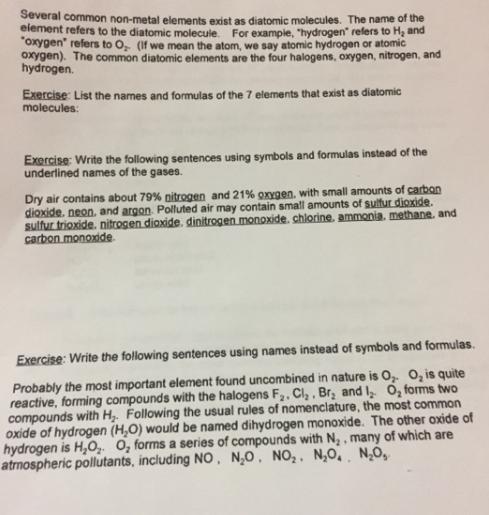Answered step by step
Verified Expert Solution
Question
1 Approved Answer
Several common non-metal elements exist as diatomic molecules. The name of the element refers to the diatomic molecule. For example, hydrogen refers to H,

Several common non-metal elements exist as diatomic molecules. The name of the element refers to the diatomic molecule. For example, "hydrogen" refers to H, and "oxygen" refers to O. (If we mean the atom, we say atomic hydrogen or atomic oxygen). The common diatomic elements are the four halogens, oxygen, nitrogen, and hydrogen. Exercise: List the names and formulas of the 7 elements that exist as diatomic molecules: Exercise: Write the following sentences using symbols and formulas instead of the underlined names of the gases. Dry air contains about 79% nitrogen and 21% oxygen, with small amounts of carbon dioxide, neon, and argon. Polluted air may contain small amounts of sulfur dioxide. sulfur trioxide. nitrogen dioxide, dinitrogen monoxide, chlorine, ammonia, methane, and carbon monoxide Exercise: Write the following sentences using names instead of symbols and formulas. Probably the most important element found uncombined in nature is O. O, is quite reactive, forming compounds with the halogens F. Cl. Br and 1 O forms two compounds with H. Following the usual rules of nomenclature, the most common oxide of hydrogen (HO) would be named dihydrogen monoxide. The other oxide of hydrogen is HO. O, forms a series of compounds with N, many of which are atmospheric pollutants, including NO, NO. NO. NO, NO
Step by Step Solution
★★★★★
3.44 Rating (160 Votes )
There are 3 Steps involved in it
Step: 1
rill Excersise Numes and us diatomic H Hydrogen Na Nitrogen F Fluorine 1 2 3 Excercise Formula...
Get Instant Access to Expert-Tailored Solutions
See step-by-step solutions with expert insights and AI powered tools for academic success
Step: 2

Step: 3

Ace Your Homework with AI
Get the answers you need in no time with our AI-driven, step-by-step assistance
Get Started


